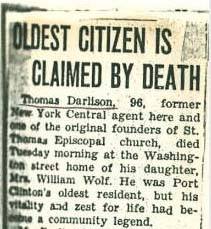Obituaries Throughout the Years


In light of this week’s celebrations of the dead with All Hallows’ Eve, All Saints’ Day, and the Day of the Dead, let’s look at one of the small ways we memorialize our loved ones—obituaries. Some may consider obituaries a depressing feature in their local newspaper, but really they celebrate the lives of citizens of their local communities, as well as those who carry national or worldly importance. In this blog post, we will explore the evolution of obituaries and look at some examples in Ohio newspapers.

An obituary is traditionally a notification of death written by a family member of the deceased and typically includes the death date, deceased and surviving family members, funeral arrangements, and often a short biographical narrative. Obituaries are published in various media, but most prominently newspapers.
Although different newspapers have varying policies, most newspapers consider obituaries to be classified advertisements and price them as such, either by word count or the number of lines used. However, there are professional obituary writers who compose lengthy obituaries for individuals who carried local, national, or international importance. Newspapers run these obituaries asnews stories rather than classified advertisements. The primary factor determining obituary length is the subject’s notoriety, and this has not changed over the course of American newspaper history.

In the 16th and 17th centuries, obituaries had a variety of titles including “Memorial Advertisements,” “Death Announcements,” and simply “In Remembrance.” During this time, obituaries were published as brief death notices, and it wasn’t until the 18th century that American newspapers began publishing longer, more memorializing obituaries. In the early-mid 19th century, obituaries were often written in verse for those whose life and death would evoke a strong emotional response, for example soldiers or politicians. By the 1880s, morbid details of the deceased’s death characterized obituaries, although Ohio newspapers did not widely adopt this thematic template.
At the turn of the century, the “common man” obituary was a widespread phenomenon, highlighting most highly-regarded qualities of ordinary people, which serve as good identifiers for historians as to what values were most important to society at a specific time. In the past, obituaries were governed by a rather formulaic structure that is now widely ignored by professional obituary writers. Modern obituaries tend to serve as a death notice with funeral details, but moreso a celebration of the person’s life and their most loved qualities.
Obituaries are an excellent resource for historians and genealogists, supplying important chronological details, but also acting as a window, albeit a narrow one, into the life of someone in the past. Whether this person held great notoriety or not, obituaries can speak to the qualities highly valued by a community or society, shed light on contemporary perceptions of death, and enlighten how we think about and react to death today.
Want to learn more about obituaries and perceptions of death in Ohio’s past? Feel free to browse the extensive newspaper collections on Ohio Memory! You might be surprised by the cheerful, or even humorous, nature of some of the obituaries.
Thanks to Kristen Newby, metadata coordinator at the Ohio History Connection, for this week’s post!
Sources:
Kemp, Thomas Jay. “Geneaology: A Brief History of Obituaries and Death Notices.”
“History of Obituaries and Death Notices.” Newspaperlinks.com.
Gilbert, Holly Shreve. “A Brief History of the Obituary.” Funeral Consumers Information Society.



Leave a Reply
You must be logged in to post a comment.